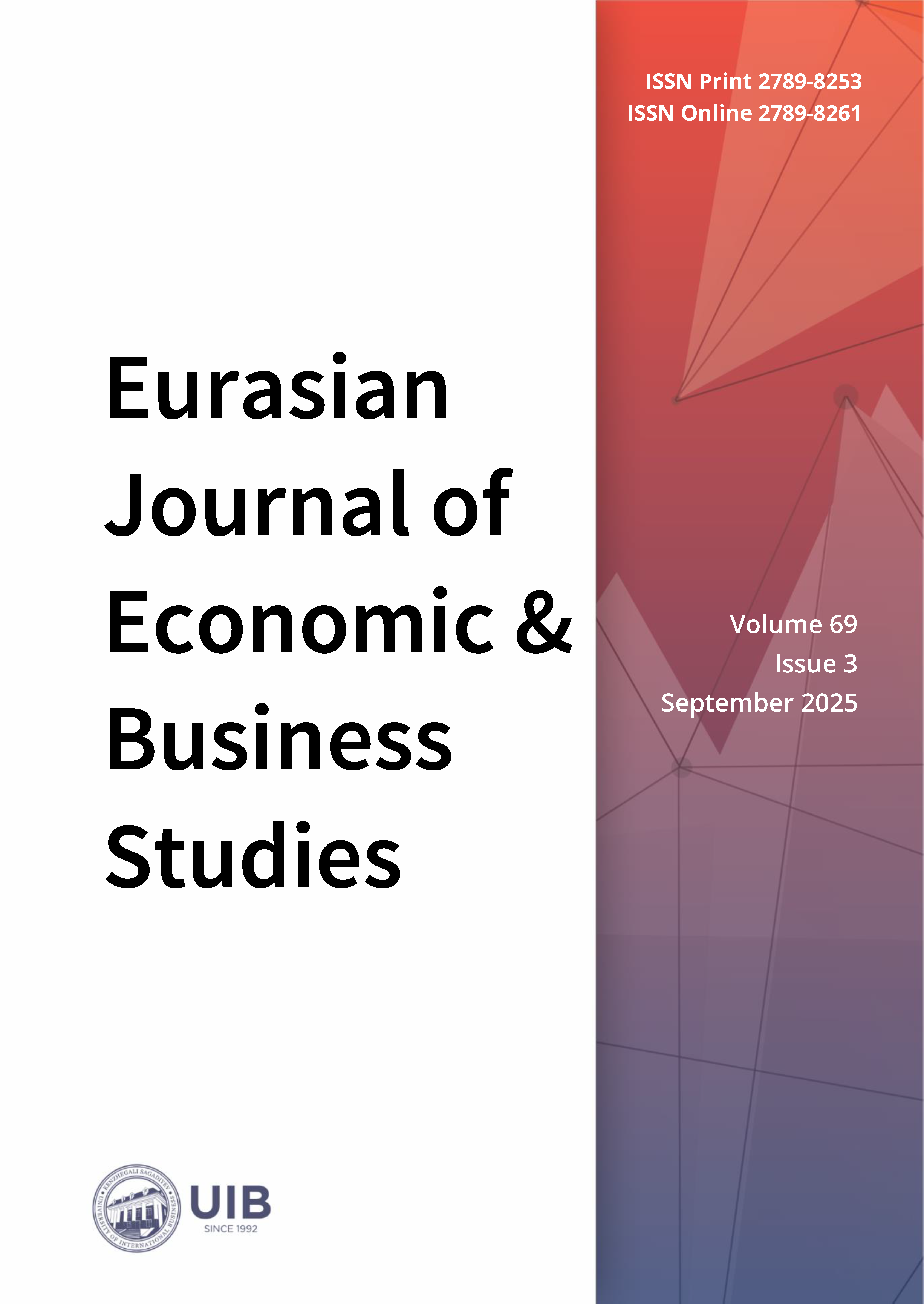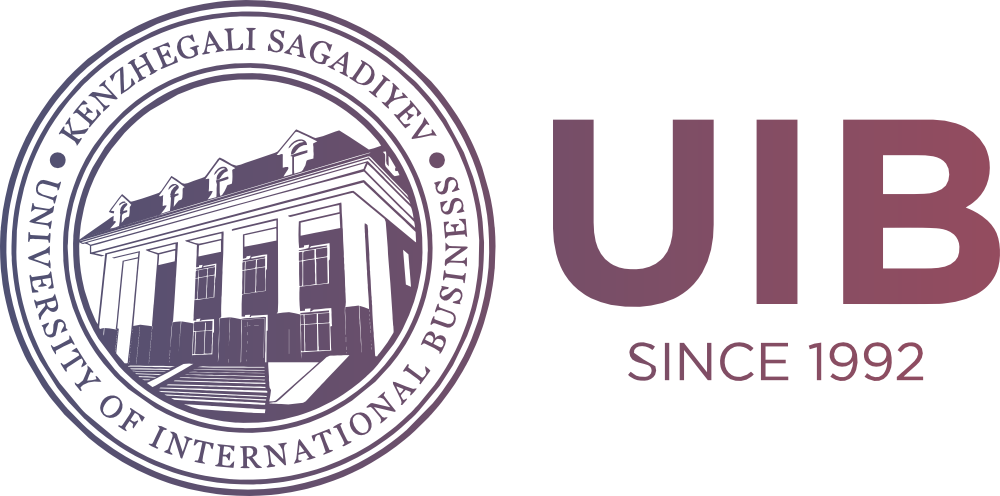ESG Approach to Financial Sustainability of Kazakhstan’s Oil and Gas Companies
DOI:
https://doi.org/10.47703/ejebs.v69i3.555Keywords:
Oil and Gas Sector, Asset Structure, Corporate Finance, Sustainability, Business Sustainability, Energy Economics, Green EconomyAbstract
The purpose of the study was to assess the impact of asset structure. It retained earnings on the strategic sustainability of oil and gas companies in Kazakhstan in the context of ESG integration. The analysis covers the period 2015–2024 and is based on the official financial statements of JSC KazMunayGas. The methodology included correlation analysis, regression modelling, ANOVA, and collinearity diagnostics. The results demonstrate that long-term assets and property, plant, and equipment (PPE) explain 97.6% of the variation in total assets (R² = 0.976, p <0.05), while retained earnings account for 71.4% of the variation in total equity (R² = 0.714, p = 0.002). Conversely, current assets and cash equivalents show no significant effect on retained earnings (R² = 0.076, p> 0.5). All three hypotheses were confirmed: long-term assets and PPE significantly explained total assets, and retained earnings significantly explained equity. The obtained results demonstrated that long-term capital-intensive investments and reinvestment of profits constitute the main drivers of ESG-oriented sustainability. In contrast, short-term liquidity plays only a supporting role. Based on these findings, government policy should strengthen the integration of ESG indicators into mandatory reporting standards and provide incentives for reinvestment of retained earnings in sustainable projects. For corporate practice, prioritizing long-term investments and transparent ESG disclosure is recommended to align Kazakhstan’s oil and gas sector with both national sustainable development priorities and international ESG standards.
Downloads
References
Aimagambetova, A., Oralbayeva, A., Akhmetova, A., & Ospanova, G. (2020). Ways to improve the enterprise's capital account. Reports of the National Academy of Sciences of the Republic of Kazakhstan, 3(331), 114. https://doi.org/10.32014/2020.2518-1483.62
Alimoradi Jaghdari, S., Mehrabanpour, M. R., & Najafi Moghadam, A. (2020). Determining the effective factors on financing the optimal capital structure in oil and gas companies. Petroleum Business Review, 4(3), 1-20. https://doi.org/10.22050/pbr.2020.255708.1133
Juravle, C., & Lewis, A. (2008). Identifying impediments to SRI in Europe: A review of the practitioner and academic literature. Business Ethics: A European Review, 17(3), 285-310. https://doi.org/10.1111/j.1467-8608.2008.00536.x
Campello, M., & Giambona, E. (2013). Real assets and capital structure. Journal of financial and quantitative analysis, 48(5), 1333-1370. https://doi.org/10.1017/S0022109013000525
Cardoni, A., Kiseleva, E., & Terzani, S. (2019). Evaluating the intra-industry comparability of sustainability reports: the case of the oil and gas industry. Sustainability, 11(4), 1093. https://doi.org/10.3390/su11041093
Ekpe, H. C. (2024). The effects of asset structure on the performance of oil and gas firms in Nigeria. ANSPOLY Journal of Advanced Research in Science & Technology, 1(1), 31-34. https://anspolyjarst.com/journal/article/view/32
Erben Yavuz, A., Kocaman, B. E., Doğan, M., Hazar, A., Babuşcu, Ş., & Sutbayeva, R. (2024). The impact of corporate governance on sustainability disclosures: A comparison from the perspective of financial and non-financial firms. Sustainability, 16(19), 8400. https://doi.org/10.3390/su16198400
Garcia, A. S., Mendes-Da-Silva, W., & Orsato, R. J. (2017). Sensitive industries produce better ESG performance: Evidence from emerging markets. Journal of cleaner production, 150, 135-147. https://doi.org/10.1016/j.jclepro.2017.02.180
Gavrikova, E., Volkova, I., & Burda, Y. (2020). Strategic aspects of asset management: An overview of current research. Sustainability, 12(15), 5955. https://doi.org/10.3390/su12155955
Hyndman, R. J., & Kostenko, A. V. (2007). Minimum sample size requirements for seasonal forecasting models. Foresight: The International Journal of Applied Forecasting, 6(Spring), 12–15. Retrieved September 05, 2025 from https://robjhyndman.com/papers/shortseasonal.pdf?utm_source
Jalilvand, A., & Kim, S. M. (2013). Matching slack resources and investment strategies to achieve long-term performance: New perspectives on corporate adaptability. The Journal of Economic Asymmetries, 10(1), 38-52. https://doi.org/10.1016/j.jeca.2013.10.001
Jenkins, D. G., & Quintana-Ascencio, P. F. (2020). A solution to minimum sample size for regressions. PloS one, 15(2), e0229345. https://doi.org/10.1371/journal.pone.0229345
KazMunayGas. (n.d.). Reporting for investors. Retrieved August 17, 2025, from https://www.kmg.kz/ru/investors/reporting/
Kolk, A., & Perego, P. (2010). Determinants of the adoption of sustainability assurance statements: An international investigation. Business strategy and the environment, 19(3), 182-198. https://doi.org/10.1002/bse.643
Koszel, M. (2025). The contemporary trends of scientific research on ESG and non-financial reporting. Scientific Papers of Silesian University of Technology. Organization & Management/Zeszyty Naukowe Politechniki Slaskiej. Seria Organizacji i Zarzadzanie, (216). http://dx.doi.org/10.29119/1641-3466.2025.216.15
Kyriazos, T., & Poga, M. (2023). Dealing with Multicollinearity in Factor Analysis: The Problem, Detections and Solutions. Open Journal of Statistics, 13(3), 404–424. https://doi.org/10.4236/ojs.2023.133020
Liu, B., & Jia, Y. (2023). Asset Structure and Company Performance. International Journal of Social Sciences and Economic Management, 4(3), 35-43. https://doi.org/10.38007/IJSSEM.2023.040305
Michalczuk, G., & Konarzewska, U. (2018). The use of GRI standards in reporting on actions being taken by companies for sustainable development. Optimum. Economic Studies, 4(94), 72-86. http://hdl.handle.net/11320/7530
Nurasheva, K. K., Shalabayev, I. I., Abdikerimova, G. I., Kulanova, D. A., & Mergenbayeva, A. T. (2024). Capital inflow and investment attractiveness of Central Asian countries (on the example of Kazakhstan). Regional Science Policy & Practice, 16(9), 100039. https://doi.org/10.1016/j.rspp.2024.100039
O’brien, R. M. (2007). A caution regarding rules of thumb for variance inflation factors. Quality & quantity, 41(5), 673-690. https://doi.org/10.1007/s11135-006-9018-6
Petrovic, N., Manson, S., & Coakley, J. (2016). Changes in Non‐current Assets and in Property, Plant and Equipment and Future Stock Returns: The UK Evidence. Journal of Business Finance & Accounting, 43(9-10), 1142-1196. https://doi.org/10.1111/jbfa.12203
Ratnayake, R. M. C., & Liyanage, J. P. (2009). Asset integrity management: sustainability in action. International Journal of Sustainable Strategic Management, 1(2), 175-203. https://doi.org/10.1504/IJSSM.2009.022832
Rezaee, Z. (2016). Business sustainability research: A theoretical and integrated perspective. Journal of Accounting literature, 36(1), 48-64. https://doi.org/10.1016/j.acclit.2016.05.003
Sohn, J., Tang, C. H. H., & Jang, S. S. (2013). Does the asset-light and fee-oriented strategy create value? International journal of hospitality management, 32, 270-277. https://doi.org/10.1016/j.ijhm.2012.07.004
Tong, T., & Kassenova, G. Y. (2025). Financial tools for managing corporate capitalization in Kazakhstan: a qualitative analysis of strategies, institutions, and market realities. International Science Journal of Management, Economics & Finance, 4(3), 75-93. https://doi.org/10.46299/j.isjmef.20250403.09
Turygin, O. M. (2018). Internal sources to increase financing for fixed investments in a company. Economy of Regions, (4), 1498. Retrieved from https://www.proquest.com/scholarly-journals/internal-sources-increase-financing-fixed/docview/2503462760/se-2
How to Cite
Downloads
Published
Issue
Section
License

This work is licensed under a Creative Commons Attribution 4.0 International License.
Authors retain copyright and grant the journal right of first publication with the work simultaneously licensed under a Creative Commons Attribution (CC-BY) 4.0 License that allows others to share the work with an acknowledgment of the work’s authorship and initial publication in this journal.



